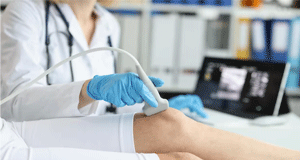Ultrasound
Ultrasoound is a totally safe noninvasive imaging technique.
Ultrasound, or Sonography, can be a very effective diagnostic tool for Orthopaedic Sugeons, as the technology has improved greatly and allows for much higher image resolution. Soft tissues that cannot be seen on x-ray, such as muscles, tendons, ligaments and joints, can be visualized easily. It is also helpful for detecting foreign bodies or abnormal growths, such as tumors or calcifications. Ultrasound can also be used to measure the bone health and density of a patient. We use advance Ultrasonic Bone Densitometer at Shreya Hospital, Ghaziabad to help our Orthopaedic Specialist in diagnosing the patient.

The real time capability of musculoskeletal sonography enables dynamic assessment of joint and tendon movements and stability, and detection of fracture union and reunion, structural abnormalities, infection, ligamentous injury, nerve compression and mechanical impingement between orthopedic hardware and soft tissue structures.
Due to its flexibility and precision in the selection of the point of examination and in the field of vision, Musculoskeletal Ultrasound has spatial, as well as temporal benefits. The possibility of placing the sonographic probe at the point of maximal tenderness increases the likelihood of detecting abnormalities, and ensures clinical relevance of the examination. Sonography affords comparisons of targeted findings with those of the contralateral side, and also enables under “vision” biopsy or joint aspiration.
Of the many indications for musculoskeletal ultrasonography, the evaluation of soft tissue pathology is particularly common. In addition, ultrasonography is useful for the detection of fluid collection, and for visualization of cartilage and bone surfaces.
Ultrasonography is preferable to radiography for the early detection of calcification in soft tissue in the neck region. In the investigation of suspected soft tissue tumors.
There are other benefits when using Ultrasound as a diagnostic tool, including:
- Real-time assessment of patient pathology
- Very low cost, compared to an MRI or CT scan
- Non-invasive, zero radiation exposure for patient
- Not painful for the patient
- Easily accessible, portable equipment
- No worry about patient claustrophobia
- Patient can be positioned comfortably during the brief exam
- Can be used safely on patients with pacemakers or other metal implants
 Dr Dev Mishra Best Orthopaedic Doctor in Delhi NCR Ghaziabad
Dr Dev Mishra Best Orthopaedic Doctor in Delhi NCR Ghaziabad
